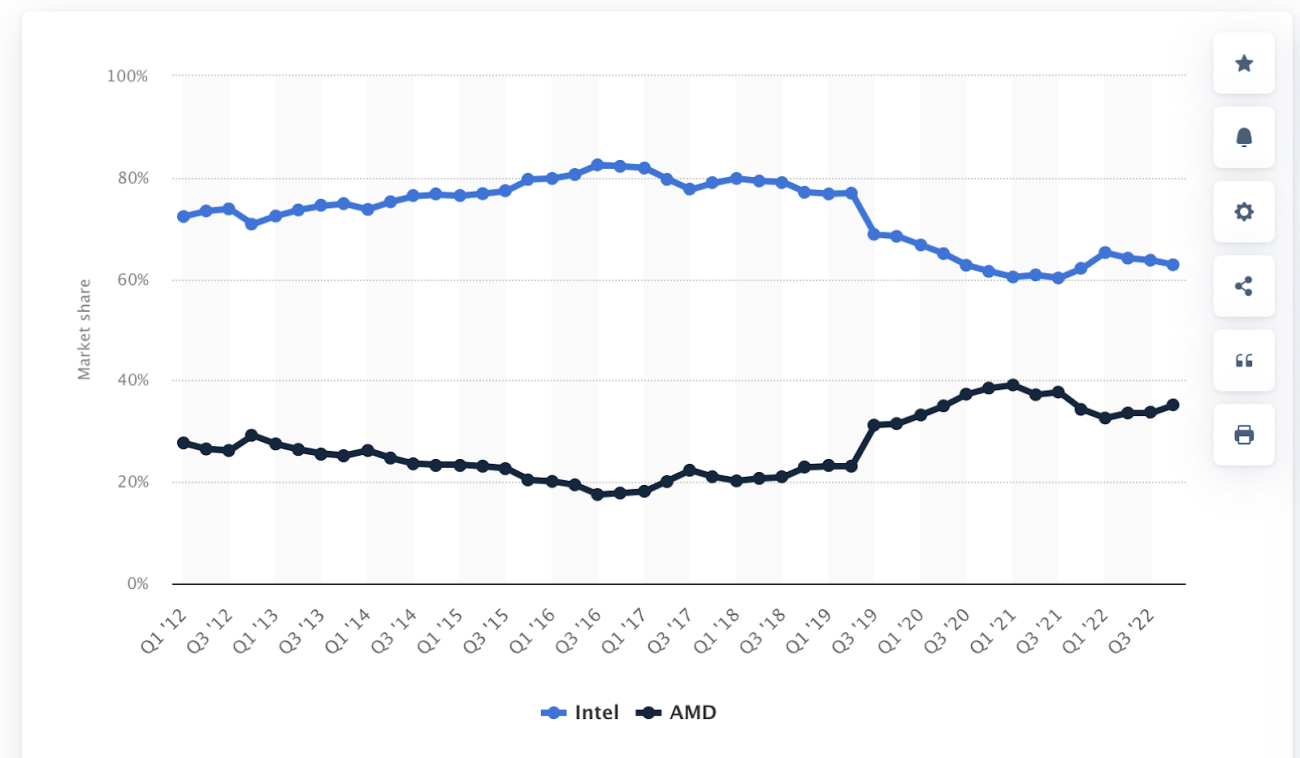|
Listen to this story
|
In 2021, Intel CEO Pat Gelsinger announced his strategy to advance five nodes in four years, which will allow Intel to become competitive with other foundries such as TSMC. Last week, Intel announced that they would be taping out 18A (18 Angstrom) and 20A production nodes for upcoming chips.
This announcement represents a clarion call that Intel has been reluctant to answer—that of actual innovation. The company’s market share in enterprise, gaming, and consumer hardware is slowly dwindling but these new nodes might be just what they need.
Data centre troubles
The last decade hasn’t gone in Intel’s favour. Ever since the launch of the Ryzen line of CPUs by AMD in 2017, Intel has been playing catch up with its competitor. This lag has resulted in a loss of market share in multiple verticals. Take, for example, Intel’s market share in x86 CPUs, representing customer devices.

Intel vs. AMD market share. (Source: Statista)
This graph shows a downtick in Intel’s market share around Q2 2019, which is roughly the same time that AMD began offering 7nm Ryzen chips. This also came at a time when Intel was reporting a decline in sales of processors to data centres, the beginning of a worrying trend.
Intel started off with close to 100% market share in the data centre segment, which declined to 97% in 2018. Competing offerings slowly cut this down to 80% by 2021, which worsened to 70% in 2022. This downturn came in the backdrop of an earnings slump in the enterprise sector, with data centre business revenue dropping from 30% of overall revenue to just over 15%.
This erosion was further compounded by the fact that 2020 and 2021 witnessed one of the biggest meltdowns in the chip industry to date. The collective US chips market was estimated to have lost about $1.5 trillion, worsened by chip shortages and fraying trade relations with China.
This downslide should have spurred Intel into action, but they ran into further roadblocks moving to a new manufacturing process. Sapphire Rapids was in development since 2015 and was hit by multiple delays due to issues with the accelerator chips embedded into the CPU. This was supposed to be Intel’s big break, reasserting their dominance after years of lacklustre performance. Instead, it was a lukewarm response (in 2023) to an AMD chip that launched in 2021.
Losing ancillary markets
To make matters worse, AMD took the entirety of the console market from them, making chips for both the PlayStation 5 and Xbox Series consoles. Simultaneously, Apple also began manufacturing the M series chips for use in the MacBooks. This was a huge blow to Intel, as they had lost one of their biggest customers. In an interview, Gelsinger spoke about Intel’s ‘stumbles’ and shortcomings in not providing a good chip to Apple, stating,
“Apple decided they could do a better chip themselves than we could. And…they did a pretty good job. So what I have to do is create a better chip than they can do themselves. I would hope to win back this piece of their business, as well as many other pieces of business, over time. And in the meantime, I got to make sure that our products are better than theirs. . .”
After losing a huge chunk of the laptop market share to Apple, Intel came up with a plan to compete with M1. With the launch of the 12th Gen CPU lineup, Intel introduced the hybrid performance- and efficiency-core architecture. The performance cores were able to boost to higher frequencies at the cost of power while the efficiency cores were able to sip power for smaller workloads. However, this wasn’t enough to challenge Apple’s dominance, as Intel’s new chips couldn’t hold a candle to M1’s power and efficiency.
When considering these factors, it seems that Intel didn’t lose against their competition: They lost against themselves. However, their new chips, projected to launch late next year, might be the secret sauce they need to get their mojo back.
New chip, new me?
Taping out sub-2nm manufacturing processes is a significant move for Intel, as they are one of the first companies in the world—apart from TSMC—to even set foot into this level of miniaturisation. Currently, what Intel has termed the 20 Angstrom and 18 Angstrom chips is nothing but a 5nm manufacturing process.
Using nanometres to define the efficiency of manufacturing processes is an inexact endeavour. For example, Intel’s 10nm manufacturing process has an equivalent transistor density to TSMC’s 7nm process. Similarly, Intel’s 7nm chips, now called ‘Intel 4’, will be equivalent to TSMC’s 4nm node.

Simply put, Intel’s 5nm manufacturing process (20A) will be able to create chips that are on par with 2nm chips from TSMC. This will finally put them back on track, catching up with their competitors and leaving their old technology behind. With the new manufacturing process described for the 20A chips, it is likely that Intel can claw back some of the performance and efficiency gains that AMD has been enjoying by shrinking their transistor dies.
Add to this the hybrid architecture that Intel has been cultivating and they might just become a force to reckon with after a long winter. Getting back market share is one thing but getting back on their feet should be priority numero uno for Intel.
Update: AIM reached out to Intel regarding this story, but they declined to comment.











































































